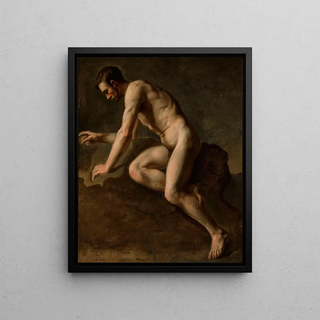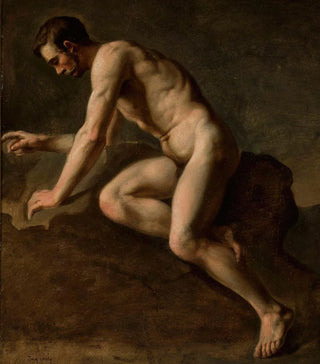Art print | Male nude study - Józef Simmler


View from behind

Frame (optional)
Józef Simmler's "Male Nude Study" artwork stands as a poignant testament to 19th-century academic mastery and artistic sensitivity. This depiction of the male body, both classical and dynamic, invites viewers to engage in deep contemplation. Through this piece, Simmler does not merely reproduce the human form; he explores the nuances of light and shadow, revealing an aesthetic that transcends mere realism. Immersing oneself in this study, one perceives not only the artist's technical virtuosity but also a reflection on the beauty and vulnerability of the human being.
Style and uniqueness of the artwork
The uniqueness of "Male Nude Study" lies in how Simmler captures the very essence of the human form. Every muscle, every curve is rendered with precision that demonstrates a profound respect for the live model. The artist skillfully plays with contrasts, using light to emphasize the three-dimensionality of the body. The model's posture, both natural and elegant, evokes a certain intimacy, as if the viewer is invited to share a moment of vulnerability. This stylistic choice, rooted in an academic tradition, is distinguished by an almost sculptural approach, where drawing becomes a means of expression as powerful as painting.
The artist and his influence
Józef Simmler, a 19th-century Polish artist, established himself in the art world through his undeniable talent and passion for studying the human body. Trained at the major art schools of his time, he was influenced by Renaissance and Baroque masters, integrating their techniques while developing his own visual language. Simmler was also a fervent advocate for arts education, firmly believing that academic training was essential to unlock artists' creativity. His work inspired many students and contemporaries, contributing to the enrichment of the European artistic landscape. Through his studies, he not only left an indelible mark on academic art but also paved the way for a deeper reflection on artistic expression.

Matte finish

View from behind

Frame (optional)
Józef Simmler's "Male Nude Study" artwork stands as a poignant testament to 19th-century academic mastery and artistic sensitivity. This depiction of the male body, both classical and dynamic, invites viewers to engage in deep contemplation. Through this piece, Simmler does not merely reproduce the human form; he explores the nuances of light and shadow, revealing an aesthetic that transcends mere realism. Immersing oneself in this study, one perceives not only the artist's technical virtuosity but also a reflection on the beauty and vulnerability of the human being.
Style and uniqueness of the artwork
The uniqueness of "Male Nude Study" lies in how Simmler captures the very essence of the human form. Every muscle, every curve is rendered with precision that demonstrates a profound respect for the live model. The artist skillfully plays with contrasts, using light to emphasize the three-dimensionality of the body. The model's posture, both natural and elegant, evokes a certain intimacy, as if the viewer is invited to share a moment of vulnerability. This stylistic choice, rooted in an academic tradition, is distinguished by an almost sculptural approach, where drawing becomes a means of expression as powerful as painting.
The artist and his influence
Józef Simmler, a 19th-century Polish artist, established himself in the art world through his undeniable talent and passion for studying the human body. Trained at the major art schools of his time, he was influenced by Renaissance and Baroque masters, integrating their techniques while developing his own visual language. Simmler was also a fervent advocate for arts education, firmly believing that academic training was essential to unlock artists' creativity. His work inspired many students and contemporaries, contributing to the enrichment of the European artistic landscape. Through his studies, he not only left an indelible mark on academic art but also paved the way for a deeper reflection on artistic expression.






